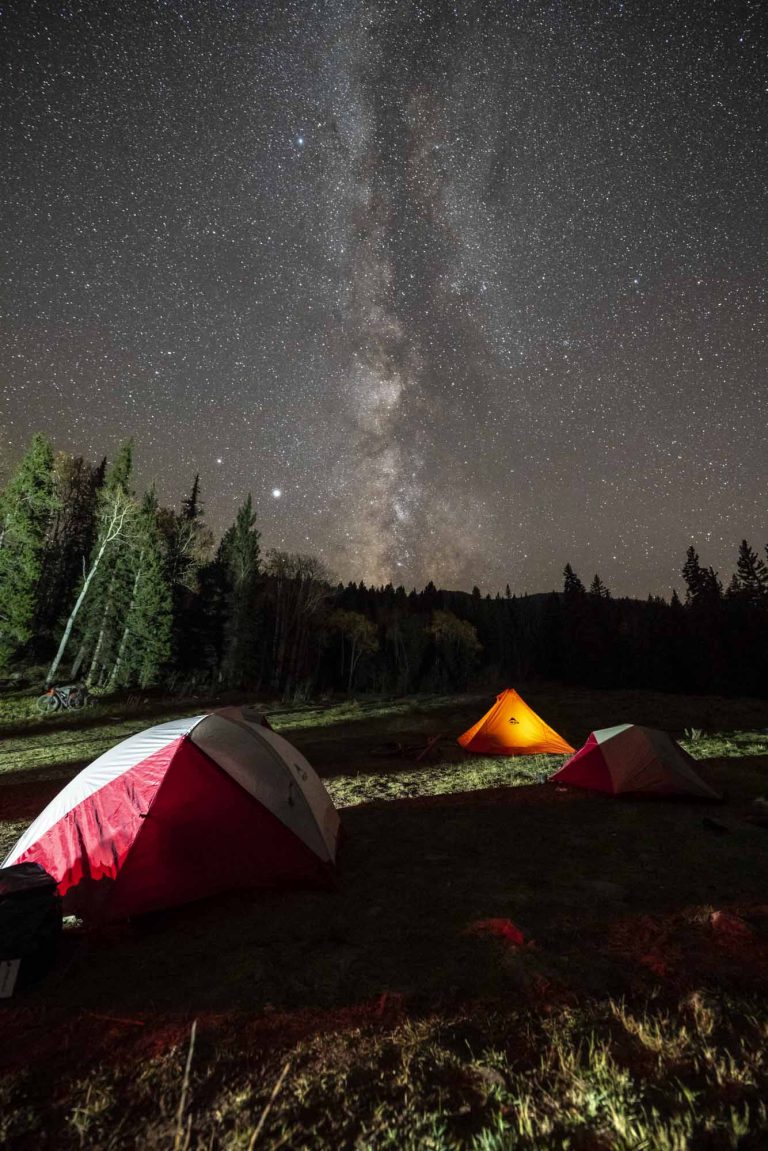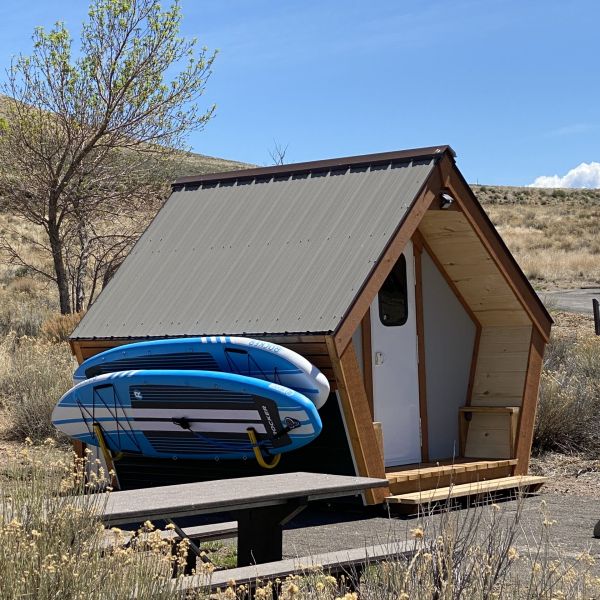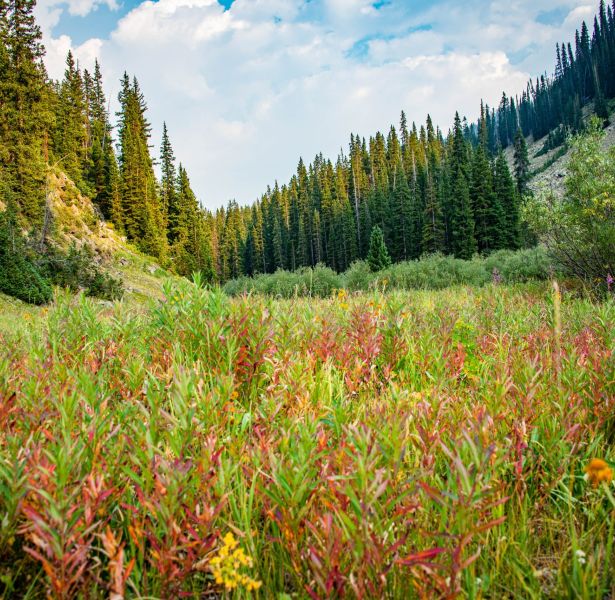CAMPING
Sleep Under The Colorado Stars
Gunnison and Crested Butte are wild and scenic destination for a camping trip. You’ll likely be able to find a spot close to your favorite hiking or mountain biking trails in spring, summer or fall. Whether you are camping in a car, tent or RV, there are many campsite options in the Gunnison Valley. Most car-accessible campsites in Crested Butte and Gunnison are designated sites, meaning that camping is only allowed in sites marked by signs. While you’re here, please take good care of our beautiful public lands so everyone can continue to enjoy them in the future. Follow the principles of Leave No Trace and be courteous to other campers and public lands users.

Plan ahead, and make a backup plan
Camping is a popular activity here. Some sites are for tents; others can accommodate RVs and fifth-wheel trailers. Some take reservations, others are first-come, first-served. It’s important to research camping spots before your trip to avoid surprises—for example, expecting a toilet at camp but finding out that there are none when you arrive. Once you know what type of camping you want to do, use the contact information and websites in this guide to learn more about specific camping areas and campgrounds.
Gunnison Valley camping map
Where to camp in Crested Butte and Gunnison
Browse the map below to find a campsite in Crested Butte, Gunnison or the surrounding areas. Click on a site to see amenities and notes about the site, such as whether four-wheel-drive is required to access the site.
Find a Campsite in Crested Butte
This guide from the U.S. Forest Service provides detailed information about designated camping in Crested Butte. Learn about responsible practices, minimizing your impact on the environment, and the differences between designated and dispersed camping. The guide also has a list of designated campsites in Crested Butte.
TYPES OF CAMPING IN THE GUNNISON VALLEY
There are four different types of camping areas in Gunnison Crested Butte — dispersed, designated, developed and private. Discover which type is the best fit for you.
WHAT IS DISPERSED CAMPING?
Dispersed camping is camping outside of a designated campground. This type of camping is available on public lands, such as National Forest or Bureau of Land Management (BLM) lands. Dispersed campsites have no amenities. This type of camping is sometimes referred to as “boondocking.” Dispersed camping is first-come, first-served, and is almost always free. To abide by the principles of Leave No Trace, dispersed camping should take place only in sites where people have camped before. See the Leave No Trace section below for tips on how to camp responsibly.
WHAT IS DESIGNATED CAMPING?
Designated dispersed camping, usually referred to simply as designated camping, is dispersed camping in sites that have been marked by land managers. Much of the camping in the Gunnison Valley is designated. With increased use, more dispersed camping zones will move to designated camping only. In designated camping zones, people who camp outside of marked sites can be ticketed (or worse). Having designated sites isolates wear and tear on the land in accord with the principles of Leave No Trace.
WHAT IS A DEVELOPED CAMPGROUND?
A developed campground is a campground managed by an entity that provides amenities. Most developed campgrounds in the Gunnison Valley are managed by the Forest Service. Amenities at developed campgrounds may include toilets, tent platforms, metal fire rings, picnic tables, running water, electric hookups, showers and more. There is usually a fee to camp in developed campgrounds. It’s important to research developed campgrounds before you arrive so you know what amenities to expect. Some developed campgrounds allow reservations; others operate on a first-come, first-served basis.
WHAT IS A PRIVATE CAMPGROUND?
A private campground is a developed campground managed by a private company, rather than a government entity such as the Forest Service.

CHANGES TO CRESTED BUTTE CAMPING
Nearly all vehicle-access campsites in the north valley have transitioned from dispersed to designated. This means that in most public lands around Crested Butte, you may only camp in sites marked by a sign like the one in this photo. Visit Crested Butte Mountain Biking Association’s website for a map and more information.
WHERE TO CAMP NEAR CRESTED BUTTE
Most of the camping near Crested Butte and Mt. Crested Butte is managed by the Forest Service. For more information on campground locations and amenities, check out the Forest Service’s Gunnison Basin Camping Guide. Certain developed campgrounds in this area, including the Lake Irwin and Lost Lake campgrounds, require reservations. Visit recreation.gov to learn more and reserve your spot.
AREA |
TYPE |
AMENITIES |
|---|---|---|
| Gothic/Schofield Pass Road | Designated and developed | Amenities vary |
| Upper East River/Poverty Gulch | Designated | Fire rings |
| Kebler Pass | Designated and developed | Amenities vary |
| Lake Irwin | Designated and developed | Amenities vary |
| Washington Gulch Road | Designated and developed | Amenities vary |
| Slate River Road | Designated and developed | Amenities vary |
| Brush Creek Road | Designated | Fire rings |
| Cement Creek Road | Designated and developed | Amenities vary |
WHERE TO CAMP NEAR ALMONT
The Forest Service manages all the non-private campgrounds in Almont, Taylor Canyon, and Taylor Park. For more information, view the Forest Service’s Gunnison Basin Camping Guide. Some campgrounds in Taylor Canyon, including Rosy Lane and One Mile, require reservations. Reserve your site and learn more at recreation.gov.
AREA |
TYPE |
AMENITIES |
|---|---|---|
| Taylor Park | Dispersed and developed | Amenities vary |
| Taylor Canyon Road | Developed | Metal fire rings, picnic tables, pit toilets |
| Spring Creek Road | Dispersed | No amenities |
WHERE TO CAMP NEAR GUNNISON
Public camping areas near Gunnison are managed by many different entities, including the Bureau of Land Management (BLM), the Forest Service and the National Park Service. To learn more about each campground or area, click its name in the chart below.
AREA |
TYPE |
AMENITIES |
|---|---|---|
| Mill Creek Road | Dispersed | Pit toilet in main parking lot |
| Hartman Rocks | Designated | Metal fire rings, picnic tables, some pit toilets |
| Black Canyon National Park | Developed | Metal fire rings, picnic tables, toilets |
| Blue Mesa Reservoir/Curecanti National Recreation Area | Developed | Metal fire rings, picnic tables, toilets |
Advice for Trailers and RVs
We recommend that all vehicles greater than 35-40 ft. do not attempt to drive beyond the following locations within each drainage due to lack of turn around space, rough roads, and/or lack of sites with adequate parking for large vehicles.
- Slate River – Musicians Camp: Approx. 6 miles from Gothic Road
- Washington Gulch – Rendezvous Meadow: Approx. 4.5 miles from Gothic Road
- Kebler Pass – Kebler Pass can accommodate RVs and trailers at all points, but avoid Splain’s Gulch and beyond the Lake Irwin established campground
- Brush Creek – Tent City: Approx. 6 miles from Highway 135. Avoid Strand Hill Road and West Brush Creek Road, as they are very rough and require high-clearance 4×4 vehicles
- Cement Creek – Cement Creek Site #8: Approx. 6 miles from Highway 135
- Gothic Road – Gothic site #13: Approx. 3.5 miles past the town of Gothic
Fire restrictions and travel information
Planning on having a campfire during your visit to Gunnison and Crested Butte? Check our Travel Alerts page first to learn about current fire restrictions and other important alerts.

Camping Tips
Here are some tips on how to make your trip stress-free and low-impact.
PRINCIPLES OF LEAVE NO TRACE: GUNNISON VALLEY EDITION
- Plan ahead and prepare. Especially if you’re planning on dispersed camping, it’s best to research several different areas and sites in advance. That way, if one area is full, you will have backup options. Informational charts on different camping areas can be found by scrolling up on this page.
- Travel and camp on durable surfaces. Drive only on established roads, and camp only in established campsites. Camp at least 200 feet away from water. Manage your vehicle and gear in a way that minimizes impacts on the land, water, plants and animals. Check out this Car Camping 101 video to learn more about how to car camp in a way that minimizes impacts on the land.
- Dispose of waste properly. Before your trip, arm yourself with both the knowledge and the gear needed to pack out all your waste. Bring enough garbage bags to pack out all your trash (even fruit peels and cores!). Learn how to properly bury human waste in case a bathroom isn’t available. Portable camp toilets and WAG bags are sold at several outdoor gear shops in Gunnison and Crested Butte. We’ve collected some helpful videos so you can learn how to deal with some of the less glamorous aspects of spending time outside.
- Leave what you find. Leave any natural or cultural objects where you found them. Never carve into the bark of Crested Butte’s famous aspen trees. Do not construct rock cairns.
- Minimize campfire impacts. Wildfires are a serious threat to the forests around the Gunnison Valley. Research and obey seasonal campfire restrictions. Use existing fire rings rather than creating new ones. Keep fires small. Always have water nearby while a fire is burning, and thoroughly extinguish fires. Several zones in the valley, including Hartman Rocks, do not have abundant firewood. If you’re not sure how plentiful wood will be in your desired camping area, purchase firewood locally to mitigate any risk of spreading parasites or non-native species. Before you camp in Crested Butte or Gunnison, be sure to check the Gunnison County fire restrictions webpage. Check out this helpful video about campfire etiquette in Colorado. Learn how to use a fire pan to limit your impact on our beautiful public lands. If campfires aren’t allowed, there are several campfire alternatives.
- Respect wildlife. Crested Butte and Gunnison are home to many different types of wildlife, including black bears. Never approach or feed animals. Store food securely. Use these three tips to respect wildlife. Learn more about hiking with moose and elk, both of which are a common sight in the Gunnison Valley. Respecting Colorado’s wildlife is important to keep our native animals and plants safe.
- Be considerate of other visitors. Everyone deserves a peaceful outdoor experience. Keep noise to a minimum and take good care of the land so future visitors can enjoy it. Follow leash laws and clean up after dogs. Learn more about how to Leave No Trace and be considerate of other visitors while doing your favorite outdoor activity, whether it’s mountain biking, hiking, fly fishing, or general trail etiquette in Colorado.
For more information on Leave No Trace ethics, visit the Center for Outdoor Ethics website.
Planning your Colorado camping trip
Be sure to check out the other spring, fall and summer activities Crested Butte and Gunnison have to offer. There are hundreds of miles of mountain biking and hiking trails, rivers to raft and fish, rocks to climb, good food to eat, and cool towns to see. Check out our trip planning page to learn more!
Find a campground
Browse local businesses below.
-

Lake Fork Marina
Lake Fork Marina is located on the west end of Blue Mesa Reservoir near Blue Mesa Dam on Hwy. 92….More info -

Amazing Glamping Adventures
Find your perfect trailer rental for your next Gunnison Valley adventure! We strive to match your…More info -

Taylor Park Trading Post
Taylor Park Trading Post was established in 1940. Our cabins, RV park, and restaurant overlook Ta…More info -

Sapinero Village Campground
Your premier location for all your recreational activities in and near Blue Mesa Reservoir.More info -

Oasis RV Resort and Cottages
Cottages, RV sites, and tent sites available. Lakeside and open year-round.More info -

Blue Mesa Outpost
Each of our accommodations envelope you with gorgeous views of Blue Mesa Reservoir and the surrou…More info -

Blue Mesa Adventure Camping Pods
Your camp is already set up when you arrive! We offer an experience that is unique to campgrounds…More info -

Campfire Ranch on the Taylor
Camp easier, rent gear and go adventure at Campfire Ranch on the Taylor. Located only 15 minutes …More info -

Three Rivers Resort
Located in Almont between Gunnison and Crested Butte at “The Gateway to Taylor Canyon,” Three Riv…More info -

Crested Butte RV Resort
You will find us just two miles south of the Town of Crested Butte in Riverland Commercial Distri…More info -
Gunnison KOA Kampground
Come and watch the grass grow is the slogan at the Gunnison KOA. Mom, dad, children and dogs will…More info -

Tall Texan RV Park and Cabins
We invite you to stay with us and enjoy the treasures of the Gunnison Territory. The Tall Texan R…More info -

Mesa Campground
Everything to make your vacation perfect! From WiFi capability to convenient shopping, you’ll fin…More info -

Thousand Trails Blue Mesa Recreational Ranch
A private RV resort, Thousand Trails Blue Mesa Recreation Ranch is a mountain hideaway 16 miles w…More info -
Palisades Senior RV Park
Welcome to the Palisades Senior RV Park located on the West side of Gunnison Co. We are a 60 site…More info
TRADITIONAL LODGING IN CRESTED BUTTE AND GUNNISON
If sleeping outside isn’t your thing, browse traditional lodging options in the Gunnison Valley.
More ideas for a trip to the Gunnison Valley
-

Summer Trails Etiquette in Gunnison and Crested Butte
Summer in Colorado is full of opportunities for adventures out on the trails. There are 1200+ miles of trails and over two million acres of public lands in Gunnison and […] -

Move to Designated Camping in Crested Butte is Complete
The Forest Service, the Gunnison County Sustainable Tourism and Outdoor Recreation (STOR) Committee and the Crested Butte Conservation Corps (CBCC) have now completed the years-long transition to vehicle-access designated camping […] -

Blue Mesa Reservoir is open for summer 2023
Blue Mesa Reservoir, located just a few miles west of Gunnison on Highway 50, is a scenic Colorado lake with an abundance of recreational opportunities. After a snowy winter, Blue […] -

Crested Butte Area Drainages Move to Designated Camping
The U.S. Forest Service in coordination with the Gunnison County Sustainable Tourism and Outdoor Recreation Committee (STOR) will transition camping offerings in Crested Butte area to create a better user […] -

Mountain Manners: Big Snow Year
2019 was a winter for the books. With precipitation for the winter at 134% of average, and 185% of average for May alone, it’s taken a bit for our trails […] -

Mountain Manners: Campfires
We love a good fire in Gunnison and Crested Butte; its hard to beat a campfire on a Colorado summer day. Before building a fire its important to know if […]
SUBSCRIBE TO OUR EMAIL NEWSLETTER!
We'll send you travel tips and news twice a month. Unsubscribe anytime!
